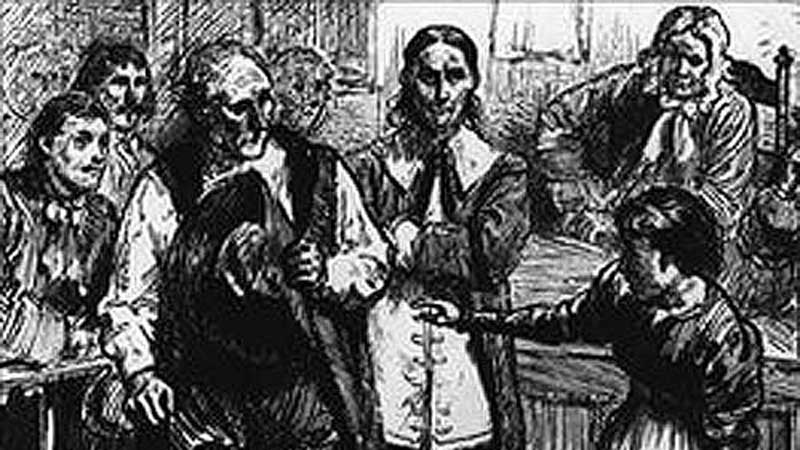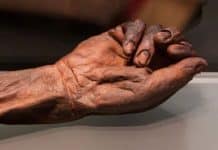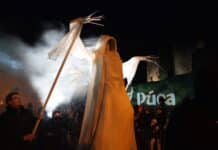ANN MASSEY takes a look at the seven most famous Irish witch trials to take place including the very first and very last witch trials on Irish soil
Biddy Early and the Magic Blue Bottle
Biddy took both her mother’s maiden name and gift for concocting herbal cures from an early age.
Rumour had it that Biddy conversed with the fairy folk and she could control them.
She married four times, the last at the age of 91 to a man in his thirties in exchange for a cure.
Her power was said to stem from a magic blue bottle and the church tried to investigate but were chased away. In 1865 Biddy was charged with Witchcraft. She was acquitted after locals refused to testify. She allegedly repented her ways on her deathbed and received a Christian burial.
The Witch of Youghal
Florence Newton of County Cork was put on trial for witchcraft in 1661 and it was so important the Irish Attorney General presided over the court case. She was accused of enchanting Mary Langdon, maid to a local wealthy dignitary.
After Florence was refused food by the maid, it was alleged that she became cursed following an altercation with Florence in the street during Mary received a forceful kiss from the slighted beggar.
This apparently caused seizures, visions, illness and poltergeist activity in the home.
While the trial notes were kept well to begin with, the remaining trial and outcome records disappeared. It was assumed she was convicted and hanged, however we will never know for sure.

The Islandmagee Witches
The trial of the eight accused witches of Islandmagee took place in the early 18th century in Northern Ireland and was one of the last to take place.
A claim was made by a local woman that a teenage girl was showing signs of demonic possession.
The girl, Mary Dunbar, with the help of the authorities, identified eight ‘witches’ from the town who she accused of demonising her by way of astral projection.
The women were convicted of witchcraft and placed in the stocks for one year. Later evidence suggest the girl had learned her lies from reading of Salem and Scotland witch trials. The question of the women’s guilt or innocence is still regularly debated today.
Goody Glover, Irish Witch of Boston
Ann ‘Goody’ Glover was born in Ireland and during the time of the Cromwellian wars was arrested alongside her husband and both were sent to Barbados as slaves.
Ann took work as a servant in a Boston household.
In 1688, as the obsession with wiping out sorcery was beginning to take hold, the children of the house all took ill.
The doctor attending cited witchcraft and Goody was accused and convicted of witchcraft and sentenced to hang.
Goody Glover was undoubtedly mentally ill and on the 300th anniversary of her execution was memorialised and given her own commemorative day on 16th November.
Alice Kyteler, Ireland’s First Convicted Witch
Alice Kyteler was the first person in Ireland to be accused of and charged with witchcraft.
Alice was a successful and ruthless business woman who ran the famous Kyteler’s Inn, still going today.
She was married four times and each husband died under mysterious circumstances, leaving her a very wealthy woman.
In 1324 the trial of Alice Kyteler began with numerous counts including colluding with a demon, sorcery and sacrifice. In 1325 Alice was convicted in absentia as she escaped during her trial.
Petronella De Meath, Burned at the Stake
Petronella was maid to Alice Kytler and was the first to be interrogated as a means to gaining evidence against her Mistress.
She was tortured ruthlessly until she confessed to witchcraft. Petronella has the gruesome claim to fame of being the first convicted witch in Ireland to be burned at the stake.
Darkey Kelly, Ireland’s First Convicted Serial Killer and Witch
Darkey Kelly was a Dublin brothel keeper in 1760. She was arrested for the murder of shoemaker John Dowling on Saint Patrick’s Day.
When authorities raided her premises, they discovered the rotting corpses of five more men hidden in the cellars of the Maiden Tower brothel.
She was also said to be the lover of one of the most prominent members of the Hellfire Club, the Sheriff of Dublin, believed to have slain their lovechild in a Satanic sacrifice and then accused the murderess of Witchcraft. Darkey Kelly was sentenced to death, partially hanged and then burned at the stake at Gallows Street.
Read 13 Spine-Chilling Irish Ghost Facts







